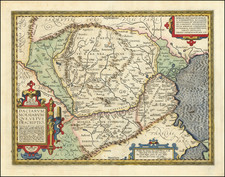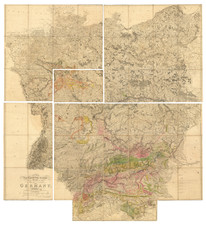An Early Illustration of the 19 Municipal Districts of Vienna
Fine rare city plan of Vienna, published in Vienna by Freytag & Brandt.
The map was issued shortly the decision was made in 1890 to expand Vienna's urban planning beyond that created in 1850 and the city fortifications constructed beginning in 1858.
The plan shows the entire newly expanded city area, with relief shown with a fine delicate hachuring. Forests are extremely dark, gardens are in light green, and other cultural genres such as vineyards are also shown.
The individual municipal districts are also differentiated in color. Districts 1 to 9 were based on the color scheme for the street and house number plates introduced in 186. The major planned infrastructure measures such as the construction of the light rail or the municipal gas works in Simmering appear, although some older road networks and street names are still used.
The line signals used by Vienna's two tramway companies are shown. A large inset map of the First District in larger scale also appears.
Freytag's plan is among the earliest plans of the city to incorporate the 19 Municipal Districts created in 1890. It also provides a fascinating transition from urban plan to a depiction of the agricultural and forested regions which had been recently incorporated into the city.
The color coding and technical details of the map are quite remarkable, providing a striking image of the city and its newest additions in the north and west.
The cover title is G. Freytag's Handplan der k.k. Reichshaupt und Residenzstadt Wien . . . "
Vienna
Modern Vienna is composed of 23 districts (Bezirke).
Prior to the 19th Century, Vienna's inner city was a fortress surrounded by fields in order to defend itself from potential attackers. In 1850, Vienna with the consent of the emperor annexed 34 surrounding villages and its defensive walls were razed after 1857, to allow for expansion of the city.
In their place, a broad boulevard called the Ringstraße was built, along which allowed for the construction of new public and private buildings, monuments, and parks by the start of the 20th century. These buildings include the Rathaus (town hall), the Burgtheater, the University, the Parliament, the twin museums of natural history and fine art, and the Staatsoper.
From 1850 to 1890, city limits in the West and the South mainly followed another wall called Linienwall at which a road toll called the Liniengeld was charged. Outside this wall from 1873 onwards a ring road called Gürtel was built. In 1890 it was decided to integrate 33 suburbs (called Vororte) beyond that wall into Vienna by January 1, 1892, and transform them into districts 11 to 19. The Linienwall was torn down beginning in 1894. In 1900, district no. 20, Brigittenau, was created by separating the area from the 2nd district.
From 1850 to 1904, Vienna had expanded on the right bank of the Danube, following the main branch before the regulation of 1868–1875. In 1904, the 21st district was created by integrating Floridsdorf, Kagran, Stadlau, Hirschstetten, Aspern and other villages on the left bank of the Danube into Vienna, and, in 1910, Strebersdorf followed.
In October 1938 the Nazis created Great Vienna with 26 districts by merging 97 towns and villages into Vienna, 80 of which (comprising 3 districts) were returned to surrounding Lower Austria in 1954.
Rarity
We were able to locate only a single example of the map in the Wiener Stadt- und Landesarchiv. No examples listed in OCLC.











![Rhetiae alpestris descriptio in qua hodie Tirolis Comitatus [with] Goritiae, Karstii, Chaczeolae, Carniolae, Histriae, et Windorum Marchae Descrip.](https://storage.googleapis.com/raremaps/img/small/83989.jpg)



![[ Railroad Map of Austro-Hungarian Empire ] Eisenbahnkarte von Oesterreich-Ungarn](https://storage.googleapis.com/raremaps/img/small/89257.jpg)
![[The Danube in Roman Times]](https://storage.googleapis.com/raremaps/img/small/74010.jpg)